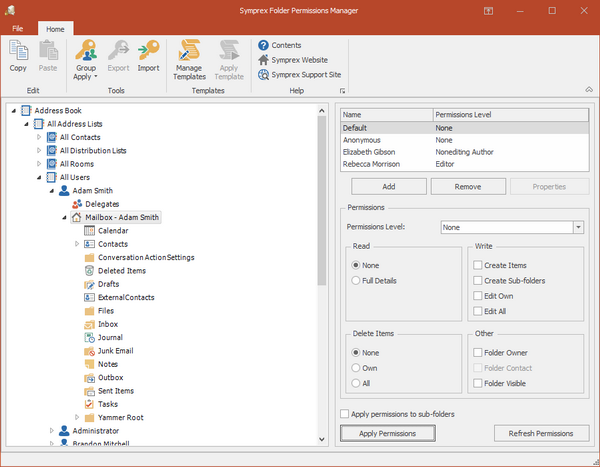
The WhatIf switch instructs the command to simulate the actions that it would take on the object.

The Server parameter specifies the server on which to perform the selected operations. The DomainController parameter specifies the fully qualified domain name (FQDN) of the domain controller that writes this configuration change to Active Directory.

You must include a colon ( : ) in the syntax. To suppress the confirmation prompt, use the syntax -Confirm:$False. The Confirm switch can be used to suppress the confirmation prompt that appears by default when this cmdlet is run. The User parameter specifies the user principal name (UPN), domain\user, or alias of the user for whom rights are being added. You can also include the path using the format TopLevelPublicFolder\PublicFolder. You can omit the parameter label so that only the public folder name or GUID is supplied. The Identity parameter specifies the GUID or public folder name that represents a specific public folder. NonEditingAuthor CreateItems, ReadItems, FolderVisible PublishingAuthor CreateItems, ReadItems, CreateSubfolders, FolderVisible, EditOwnedItems, DeleteOwnedItemsĪuthor CreateItems, ReadItems, FolderVisible, EditOwnedItems, DeleteOwnedItems PublishingEditor CreateItems, ReadItems, CreateSubfolders, FolderVisible, EditOwnedItems, EditAllItems, DeleteOwnedItems, DeleteAllItemsĮditor CreateItems, ReadItems, FolderVisible, EditOwnedItems, EditAllItems, DeleteOwnedItems, DeleteAllItems Owner CreateItems, ReadItems, CreateSubfolders, FolderOwner, FolderContact, FolderVisible, EditOwnedItems, EditAllItems, DeleteOwnedItems, DeleteAllItems This parameter accepts the following values for roles: In addition to access rights, you can create rights based upon roles, which includes multiple access rights. The user can’t read items, edit items, delete items, or create items.įolderContact The user is the contact for the specified public folder.įolderVisible The user can view the specified public folder, but can’t read or edit items within the specified public folder. The user has the right to view and move the public folder and create subfolders.

This parameter accepts the following values: ReadItems The user has the right to read items within the specified public folder.ĬreateItems The user has the right to create items within the specified public folder.ĮditOwnedItems The user has the right to edit the items that the user owns in the specified public folder.ĭeleteOwnedItems The user has the right to delete items that the user owns in the specified public folder.ĮditAllItems The user has the right to edit all items in the specified public folder.ĭeleteAllItems The user has the right to delete all items in the specified public folder.ĬreateSubfolders The user has the right to create subfolders in the specified public folder.įolderOwner The user is the owner of the specified public folder. The AccessRights parameter specifies the rights being added. More information on these commands below: Add-PublicFolderClientPermissionĪdd-PublicFolderClientPermission -Identity -AccessRights -User ] ]

The -User flag I original thought was the domain account such as dom\joseph.bloggs however it would appear that the command wanted the mailbox (display) name instead.


 0 kommentar(er)
0 kommentar(er)
